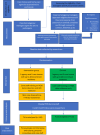PREVENTion and treatment of incontinence-associated dermatitis through a codesigned manual (PREVENT-IAD): a study protocol for a feasibility cluster randomised controlled trial with a nested process evaluation
- PMID: 39719286
- PMCID: PMC11667359
- DOI: 10.1136/bmjopen-2024-092338
PREVENTion and treatment of incontinence-associated dermatitis through a codesigned manual (PREVENT-IAD): a study protocol for a feasibility cluster randomised controlled trial with a nested process evaluation
Abstract
Introduction: Incontinence is commonly experienced by adults who receive care support in a residential facility or in their own home. These individuals are at risk of developing incontinence-associated dermatitis (IAD), which is caused by prolonged and repeated exposure of the skin to urine or faeces. An IAD manual was developed providing an evidence-based clinical algorithm and an e-learning training programme for the prevention and treatment of IAD. The aim of the study is to establish the feasibility of conducting a definitive trial to examine the clinical and cost-effectiveness of the IAD manual. The objectives are to assess recruitment and attrition rates, acceptability of the IAD manual and intervention fidelity.
Methods and analysis: A feasibility cluster randomised controlled trial will be conducted in residential nursing homes and in the homes of people receiving formal care support in London and Hampshire, England. A total of six clusters including n=248 participants who are incontinent of urine, or faeces will be included. At each intervention site, care staff will be trained to implement the IAD manual over a 6-month period. Quantitative outcomes include IAD incidence and severity, IAD-related pain, satisfaction with care and mental health. A qualitative evaluation of care staff and care receivers' experiences of participation will be conducted. Rates and proportions of each feasibility outcome will be described informing the sample size estimation for a definitive cluster randomised controlled trial. A thematic analysis of the qualitative data will be guided by a logic model detailing potential factors impacting on both the study methodology and adoption of the IAD manual into routine care.
Ethics and dissemination: The study received the approval of the Queens Square Ethics Committee Health Research Authority 23/LO/036, (Project ID 296167). Results will be disseminated through peer-reviewed open-access journals and international conferences TRIAL REGISTRATION NUMBER: ISRCTN70866724.
Keywords: Clinical Trial; DERMATOLOGY; Feasibility Studies; Urinary incontinences; WOUND MANAGEMENT.
© Author(s) (or their employer(s)) 2024. Re-use permitted under CC BY. Published by BMJ Group.
Conflict of interest statement
Competing interests: DB declares the following conflict of interest: Molnlycke Health Care US, LLC (Independent Contractor—Consultant); Urgo Medical North America, LLC (Independent Contractor—Consultant); 3M Company (Independent Contractor—Consultant). JK declares the following conflicts of interest: Molnlycke Health Care US; LLC (Independent Contractor—Consultant); Hartman AG (Independent Contractor—Consultant); Arjo (Grant/Contract); 3M Company (Independent Contractor). CN declares the following conflicts of interest: Speaker fees from: Janssen, WebMD, Medscape, Merck Pharmaceutical; Tillotts Pharma UK; Pfizer advisory board. CC declares the following conflicts: Attends UK Ltd—presentation funding; Clinisupplies UK Ltd—presentation/conference funding. SW; TG; SS; MF; RH; PW; FF; JMF declare no conflicts of interest.
Figures
Similar articles
-
Comparison of two skin protection regimes for the Prevention of Incontinence-associated Dermatitis in geriatric care (PID): a study protocol for an exploratory randomised controlled pragmatic trial.BMJ Open. 2022 Sep 29;12(9):e065909. doi: 10.1136/bmjopen-2022-065909. BMJ Open. 2022. PMID: 36175092 Free PMC article.
-
A 3-in-1 perineal care washcloth impregnated with dimethicone 3% versus water and pH neutral soap to prevent and treat incontinence-associated dermatitis: a randomized, controlled clinical trial.J Wound Ostomy Continence Nurs. 2011 Nov-Dec;38(6):627-34. doi: 10.1097/WON.0b013e31822efe52. J Wound Ostomy Continence Nurs. 2011. PMID: 21952346 Clinical Trial.
-
The effectiveness of a hydrocolloid crusting method versus standard care in the treatment of incontinence-associated dermatitis among adult patients in an acute care setting: A randomised controlled trial.J Tissue Viability. 2023 May;32(2):171-178. doi: 10.1016/j.jtv.2023.01.007. Epub 2023 Jan 23. J Tissue Viability. 2023. PMID: 36717288 Clinical Trial.
-
Development and evaluation of a de-escalation training intervention in adult acute and forensic units: the EDITION systematic review and feasibility trial.Health Technol Assess. 2024 Jan;28(3):1-120. doi: 10.3310/FGGW6874. Health Technol Assess. 2024. PMID: 38343036 Free PMC article.
-
Pelvic floor muscle training for preventing and treating urinary and faecal incontinence in antenatal and postnatal women.Cochrane Database Syst Rev. 2020 May 6;5(5):CD007471. doi: 10.1002/14651858.CD007471.pub4. Cochrane Database Syst Rev. 2020. PMID: 32378735 Free PMC article.
Cited by
-
Incontinence-Associated Dermatitis in Older Adults: A Critical Review of Risk Factors, Prevention and Management.Drugs Aging. 2025 Aug;42(8):745-754. doi: 10.1007/s40266-025-01227-z. Epub 2025 Jul 4. Drugs Aging. 2025. PMID: 40615652 Free PMC article. Review.
References
Publication types
MeSH terms
LinkOut - more resources
Full Text Sources
Medical


